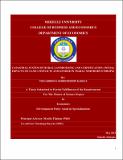| dc.description.abstract | Land has been the center of socio-economic and political debate since time immemorial. One
of the main reasons for the increasing incidence of land-related conflicts; failure of land tenure systems to
respond to the increasing land pressures and that this undermines investment incentives and land
productivity. Women’s empowerment as a development goal is based on a dual justification: empowering
women is by itself social justice and it is a means to other ends.
Methods: The paper is based on the information from 279 households, 116 treated and 163 comparisons of
Raya-Azebo woreda, Northern Ethiopia. After creating the common support through matching, logit and
ordered logit models are employed to see the parametric relationships. OLS is also used in estimating the
decision index of women empowerment.
Results: The intervention seems to bring marked results in terms of reduction in the level of border conflict,
perceived risk of encroachment and concern of border disputes. Farm size failed to significantly affect the
change in border disputes. Nevertheless, other plot characteristics like clear demarcation, soil type, slope of
the land, plot distance from the residence of the households; and household characteristics are found to
significantly affect the variation in the probability of border disputes. In all the treated and non treated,
gender of household head explains the variation in conflict in such a manner that those households with
male headed have lower probability of border disputes as compared to the female headed households.
There is no strong evidence (at least statistically) if participation in to the program has brought a change in
the perception of women on equality with men counterparts. The same is true for the variable decision
making on income earned of the household. Though the sign of change is encouraging, we cannot argue that
participation in to the program has brought about an increase in the fall-back option or threat point and
hence bargaining power of women in the study area, at its initial phase of implementation.
Conclusions: The overall objectives of the intervention are, among others, reduction in border conflicts, and
empowering women through joint titling. In its initial phase, the program is succeeding in border conflicts,
though cannot avoid it totally. Border conflict is still the problem both in the treated area and comparison
area, though there is improving trend as hypothesized. With regard to gender empowerment, our focus of
analysis was on decision making, contribution to family income and self esteem of women. With the results
we find, we failed to conclude that the intervention has brought significant difference, though the sign of
change is improving. | en_GB |


